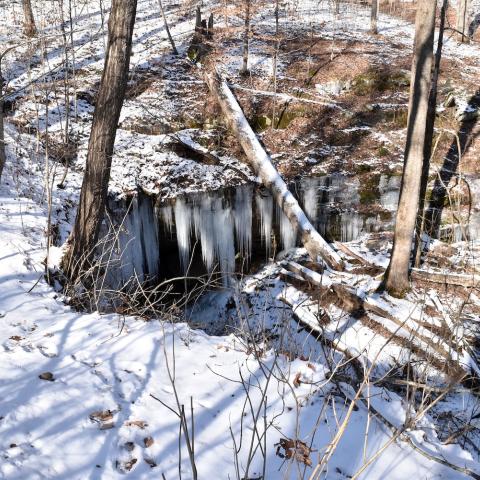
Cleaveland Avenue, Mammoth Cave National Park / NPS file
Mammoth Cave National Park in Kentucky celebrates the world’s longest known cave system at over 426 miles (686 km). This national park is home to unique wildlife (eyeless fish and transparent cave shrimp), unique history (saltpetre mining and TB huts), and unique geology (karst topography, speleothems, and fossil sharks). While there’s plenty to see, do, and learn about the cave itself, there are also ground-level activities including trails to hike and bike and a couple of rivers to paddle, plus a broad panoply of people and places contributing to this national park’s history.
It’s a no-brainer you’ll want to purchase a ticket to reserve a spot on one of the 18 very popular cave tours currently offered by the park. Tours range from the easy, 2-hour Accessible Tour to the strenuous 6-hour Wild Cave Tour, where you’ll get down and dirty crawling through holes and squeezing between narrow passageway openings with names like “Fat Man’s Misery.”
During these tours, rangers explain cave-forming processes, karst geology, and creation of speleothems (cave formations). These experienced guides will also regale you with stories of the adventurous cavers who have explored and continue to explore this cave, and why there are TB huts and the remains of saltpetre mining tools within the cave’s passageways. You’ll also learn about the treasure trove of fossil finds within the cave itself, including 70 species of shark. Tour tickets are sold through recreation.gov and it’s a good idea to reserve a spot as soon as possible.
If you are claustrophobic or prefer remaining at ground level, there are 18 miles (29 km) of easily-accessed trails, plus over 60 miles (97 km) of backcountry trails on which to stretch your legs while offering scenic ridge, river, sinkhole, stream, and forest views. Some of these trails might even lead you to one of over 80 known cemeteries in which rest people who called the park their home.
Speaking of people, you’ll learn the history of those who directly or indirectly played a part in Mammoth Cave National Park’s history, from eminent domain forcing residents from their homesteads, to the Civilian Conservation Corps building and improving the park’s roads, trails, and infrastructure, to the Cave Wars and potential for nearby landowners’ commercial success thanks to a curious public.
This national park is home to a wide variety of wildlife, both above and below ground, including 70 species listed as threatened or endangered. Most commonly-seen above ground are squirrels, and deer. Rarer sightings include coyotes, black bears, and 13 species of bats. Below ground live some 160 animal and invertebrate species ranging from very long-legged cave crickets to pale, eyeless fish, to a translucent shrimp found nowhere else in the world.
Feel like spending a night or two inside the park? The Lodge at Mammoth Cave offers the closest option for overnight stays in the park and is conveniently located directly next to the visitor center.
If you’d rather pitch a tent beneath the stars, Mammoth Cave National Park offers three frontcountry campgrounds as well as backcountry and riverside camping. From there, you can gaze up at the starry sky with little light pollution interference.
Traveler’s Choice For: caving and cave tours, history, geology, photography, paddling



 Support Essential Coverage of Essential Places
Support Essential Coverage of Essential Places






